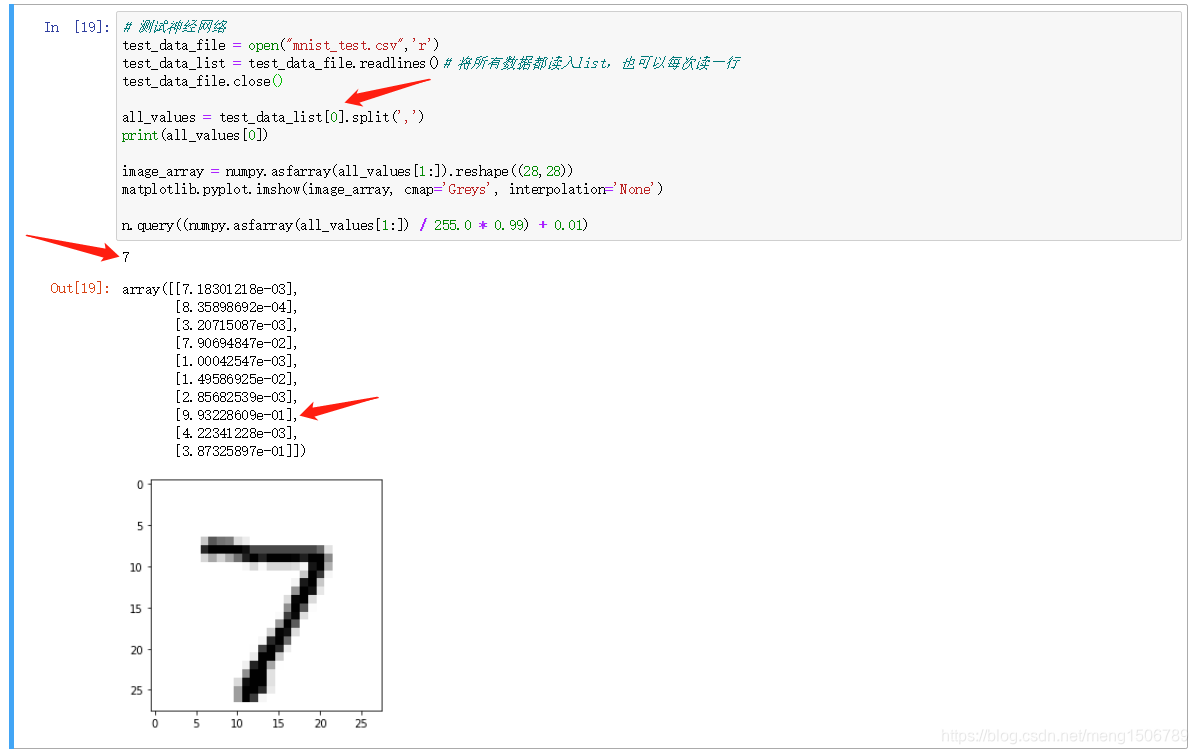功能描述
基于手写数字的数据集,实现神经网络的训练和推理。
http://pjreddie.com/projects/mnist-in-csv/
http://www.pjreddie.com/media/files/mnist_train.csv
http://www.pjreddie.com/media/files/mnist_test.csv
Python源代码
#!/usr/bin/env python
# coding: utf-8
# In[1]:
import numpy
import scipy.special # 这个库包含sigmoid函数,叫做expit()
import matplotlib.pyplot # 导入绘图库
# In[2]:
#创建神经网络类,至少有3个函数 :
#初始化函数--设定输入层节点、隐藏层节点和输出层节点的数量,学习率设定
#训练 --学习给定训练集样本后,优化权重
#查询 --给定输入,从输出节点给出答案
# neural network class definition
class neuralNetwork :
# initialise the neural network
def __init__(self, inputnodes, hiddennodes, outputnodes, learningrate) :
# set number of nodes in each input, hidden, output layer
self.inodes = inputnodes
self.hnodes = hiddennodes
self.onodes = outputnodes
# learning rate
self.lr = learningrate
# link weight matrices, wih and who
# weight inside the arrays are w_i_j, where link is from node i to node j in the next layer
# w11 w21
# w12 w22 etc
# 初始化权重值为-0.5 ~ 0.5的随机数,注意行和列不要弄反了
self.wih = (numpy.random.rand(self.hnodes, self.inodes) - 0.5)
self.who = (numpy.random.rand(self.onodes, self.hnodes) - 0.5)
# 可选操作:使用正态分布的随机数初始化权重,中心为0.0
#self.wih = numpy.random.normal(0.0, pow(self.hnodes, -0.5),(self.hnodes, self.inodes))
#self.who = numpy.random.normal(0.0, pow(self.onodes, -0.5),(self.onodes, self.hnodes))
# 定义激活函数为sigmoid: 这个函数接收x作为输入,expit(x)为输出
self.activation_function = lambda x:scipy.special.expit(x)
pass
# train the neural network
def train(self, inputs_list, targets_list):
# convert inputs list to 2d array
inputs = numpy.array(inputs_list, ndmin=2).T
targets = numpy.array(targets_list, ndmin=2).T
# calculate signals into hidden layer
hidden_inputs = numpy.dot(self.wih, inputs)
# calculate the signals emerging from hidden layer
hidden_outputs = self.activation_function(hidden_inputs)
# calculate signals into final output layer
final_inputs = numpy.dot(self.who, hidden_outputs)
# calculate the signals emerging from final output layer
final_outputs = self.activation_function(final_inputs)
# output layer error is the (target - actual)
output_errors = targets - final_outputs
# hidden layer error is the output_errors, split by weights, recombined at hidden nodes
# 重点!!反向传播误差
hidden_errors = numpy.dot(self.who.T, output_errors)
#更新权重:w=w+mu*e(n)*sigmoid(final_inputs)的导数*vector_u;
# update the weights for the links between the hidden and output layers
# 其中:*表示对应元素的乘法,dot表示矩阵的点积
self.who += self.lr * numpy.dot((output_errors * final_outputs * (1.0 - final_outputs)), numpy.transpose(hidden_outputs))
# update the weights for the links between the input and hidden layers
self.wih += self.lr * numpy.dot((hidden_errors * hidden_outputs * (1.0 - hidden_outputs)), numpy.transpose(inputs))
pass
# query the neural network
def query(self, inputs_list) :
# 转换inputs_list为二维数组,以便于计算
inputs = numpy.array(inputs_list, ndmin=2).T
# 矩阵相乘
hidden_inputs = numpy.dot(self.wih, inputs)
# 激活
hidden_outputs = self.activation_function(hidden_inputs)
# 矩阵相乘
final_inputs = numpy.dot(self.who, hidden_outputs)
# 激活
final_outputs = self.activation_function(final_inputs)
return final_outputs
# In[3]:
# number of input, hidden and output nodes
input_nodes = 784 # 28*28=784
hidden_nodes = 100
output_nodes = 10
# learning rate is xxx
learning_rate = 0.3
# create instance of neural network
n = neuralNetwork(input_nodes, hidden_nodes, output_nodes, learning_rate)
# In[4]:
# 读取训练集文件数据(首先要将数据上传到网站上file-open-upload)
training_data_file = open("mnist_train_500.csv",'r')
training_data_list = training_data_file.readlines()# 将所有数据都读入list,也可以每次读一行
training_data_file.close()
# In[5]:
# 开始训练神经网络
for record in training_data_list:
all_values = record.split(',')
# image_array = numpy.asfarray(all_values[1:]).reshape((28,28))
# matplotlib.pyplot.imshow(image_array, cmap='Greys', interpolation='None')
# 将数据转换为0.01~1.00范围内
# 选择0.01作为最低点为了避免先前观察到的0值输入会人为地造成权重更新失败
# 输入值可以是1.0,但是输出值不可以
inputs = (numpy.asfarray(all_values[1:]) / 255.0 * 0.99) + 0.01
# 构建目标输出,使用0.01和0.99分别代替0和1作为目标,防止饱和网络(sigmoid不能输出1和0)
targets = numpy.zeros(output_nodes) + 0.01 # 目标输出是10个数据
targets[int(all_values[0])] = 0.99
n.train(inputs, targets)
pass
# In[6]:
# 测试神经网络
test_data_file = open("mnist_test.csv",'r')
test_data_list = test_data_file.readlines()# 将所有数据都读入list,也可以每次读一行
test_data_file.close()
all_values = test_data_list[0].split(',')
print(all_values[0])
image_array = numpy.asfarray(all_values[1:]).reshape((28,28))
matplotlib.pyplot.imshow(image_array, cmap='Greys', interpolation='None')
n.query((numpy.asfarray(all_values[1:]) / 255.0 * 0.99) + 0.01)
运行结果
通过修改test_data_list数组的编号,可以选择不同的数据进行测试。
输出一个array,其中最大的数的编号就是得到的数字结果。

